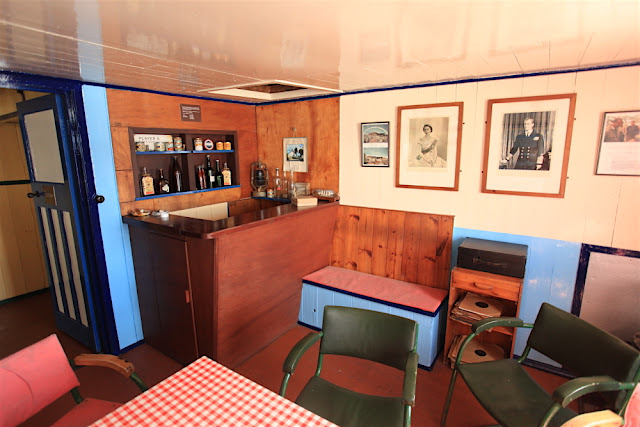The final leg of this voyage to the Antarctic Peninsula was made by visiting two stations - one currently active in research and the other having been repurposed for the tourism trade. This year, some 40,000 people will visit the continent of Antarctica, with 33% of them hailing from the United States. The second country is Australia at 5%.
December 28
Going by Zodiac from The World to Palmer Station. It can be tricky navigating through the icebergs and bergy bits that often choke the narrow harbor and one of our boats was utilized just to push them away to make a channel.
Sign to the entrance at Palmer Station which has the coordinates of 64.77°S, 64.05°W. Check out the live webcam from Palmer Station here.
Sign welcoming The World to Palmer Station. We were the first ship to arrive this season!
View from the balcony on the main building. We accompanied station personnel on a tour of the rather small facility, that has a maximum population of 46.
This building is where fresh water is made for the base by the reverse osmosis process.
Most Antarctic stations have mileage posts to show how far it is to various places. This tradition began as Antarctica was often deemed the end of the earth. The South Pole is 1,744 miles away - to the south.
View of the aquarium where much of the marine research takes place. Scientists have found that the sea ice here begins to form later in the autumn (April) and melts earlier in the spring (October). This simple fact accounts for many ancillary changes in the ecosystem. Frozen sea water lasts 90 less days now than what was observed in 1978. This allows the wind to mix the upper and lower water column for a longer period of time, which alters the micro-biota of plankton and algae. This in turn changes the amount of krill, since they feed on the micro-biota. Changes in krill populations affect the penguin populations, such that there are many less Adelie penguins now and more gentoos.
The average winter temperature at Palmer Station since 1950 has risen five times faster than the global average. At Palmer Station, the winter temperature has risen an average of 2 degrees F. each decade since then, for a total rise of 11 degrees Fahrenheit!
December 29
We next visited Port Lockroy, the old British Base "A". The British named all their stations alphabetically, with this being the first of a secret World War II program called Operation Tabarin.
I was scheduled to be a Zodiac driver for persons going ashore here, so I got a chance to cruise around an interesting and photogenic iceberg.
Many people wonder about the blue color seen in these bergs.
Here is a visual from my lecture given on board, "The Landscapes of Antarctica: Rocks, Ice, and Time." Only the blue wavelength is short enough to escape the ice.
Icicles dripping from the bergs.
The welcoming sign at Port Lockroy. When I first came here in 1993, the base stations were abandoned and neglected. We entered the buildings with snow and ice on the floors.
Now, the buildings have been weatherized and are maintained by the Antarctic Heritage Trust, a non-profit in the UK dedicated to preserving the history of these old stations. Have look at the wonderful restoration that has happened here since 1996.
The bar area where men would relax and unwind.
A typical bunk bed in the sleeping quarters. When the station was being renovated, workers discovered beneath coats of paint, images of famous movie stars like Jane Russell, Marilyn Monroe, and others.
Looking across the Neumayer Channel to Anvers Island after leaving Port Lockroy.
This mountain is higher than the Grand Canyon is deep but with little scale to use as reference, it is difficult to fathom how big this place is.
As we set out into the open ocean, large icebergs dotted the seascape. We were leaving Antarctica for South America as this trip comes to an end. But...I will be on a second voyage that will include Elephant Island, South Georgis and the Falkland Islands so please keep reading! Cheers.





















The photos are fantastic! The change in climate and its effect on the ecosystem undoubtedly will be long-reaching. Thanks for the great documentation!
ReplyDeleteInteresting to say the least. I've had enough frigid cold here in Sweden to want to visit such a place, although I would like to see Greenland in Summertime. Only reason I could think to go to Antarctica would be to find if that Shackleton Expedition had anymore hidden cases of the 1800s Scotch Whiskey
ReplyDelete